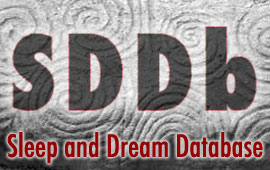That’s a question I’ve learned from Tracey Kahan to ask whenever I study a set or series of dreams. If I find, for example, that 13% of a given collection of dreams include words related to fire, I can only assess the significance of that number in comparison to some other collection of dreams. Maybe 13% is unusually high, maybe it’s unusually low; we can’t say for sure unless we have some kind of standard or baseline against which to compare it.
For the past half century, the Hall and Van de Castle (HVDC) Norm Dreams have been used as a general baseline to compare the content analysis findings of other sets or series of dreams. No disrespect to Hall or Van de Castle, but I’ve always thought it would be good for the field of dream studies to develop a baseline that includes input from more than just 200 college students from 1950’s Ohio. We have indeed learned a great deal from that set of dreams, and now it’s time to widen our perspective. One of my goals with the SDDb is to expand the HVDC approach by creating a bigger and better baseline for studying patterns in dream content.
Any dream research baseline, short of a total collection of all human dreams ever experienced, will inevitably be partial and limited, a tiny fraction of the totality of human dreaming. This fact imposes an obligation of humility on those who pursue this kind of research. A baseline is a pragmatic tool we create and use to help answer our questions, not a perfect representation of objective reality.
That said, it is not only possible but extremely important to make reasonable distinctions between better and worse baselines.
The bigger and more broadly based, the better. The larger the database, the more likely the patterns in content are genuine and not just statistical noise (though we can never be absolutely sure).
Always, always, quality of data is essential–garbage in, garbage out, no matter how big your N.
The baseline’s sources should be very transparent, so researchers can make informed decisions about how much weight to give the results comparing their data with the baseline.
The HVDC Norm Dreams are divided by gender, and I think this is a good practice to continue for a couple of reasons. First, there do seem to be significant differences between male and female dreaming, so creating a baseline for each gender offers a more precise tool for comparative research. Second, many studies have a drastic imbalance in the gender of their participants, specifically a much higher proportion of female than male dream reports. Hence the practical importance of offering a baseline for each gender, to facilitate the analysis of these kinds of imbalanced sets. (Why it’s easier to gather female than male dreams is a separate topic of discussion.)
Baseline frequencies for dream content will be sensitive to the word counts of the reports. A collection of extremely long dreams will likely have higher frequencies of ALL categories of content, while a collection of extremely short dreams will likely have lower frequencies across the board. The HVDC set draws the line at 50 words minimum and 300 words maximum. I’m willing for now to go along with that policy, though eventually I want to return to consider what we may be losing by excluding shorter and longer dream reports.
What types of dreams should be included in a general baseline for dream research? That’s a trickier question. Should it blend together many different types of dreams, or should it concentrate on a single generic type of dream?
Many researchers have opted for the latter approach. The HVDC Norm Dreams include five dream reports from each participant, presumably recent dreams from the previous few nights, although several of the dreams are recurrent and/or come from an earlier time of life. It’s not a “pure” set, but it purports to be a reasonable selection of the average dreams of this group of people.
Sleep laboratory researchers like David Foulkes have argued that dreams gathered in a home setting are too unreliable and only dream reports gathered in a controlled laboratory setting with accompanying sleep stage data should be considered when assessing basic patterns in dream content. However, Bill Domhoff has made the case that dream reports gathered outside the lab setting can also be a valid source of insight, especially questionnaires asking people to describe their “most recent dreams.”
The difficulty in defining what counts as the most generic type of dream makes this approach problematic. Another drawback is the under-reporting of the incidence of rare but intense and highly memorable types of dreams–nightmares, lucid dreams, visitation dreams, recurrent childhood dreams, etc. These exceptional types of dreams may not occur as frequently as ordinary dreams, and thus they do not appear as often when people are asked to describe their most recent dreams. But these unusual dream types are widely experienced and reflect important features of the dreaming mind that we need to account for in any general theory of dream psychology. We lose sight of those features when we focus only on allegedly “average” dreams.
The advent of database technology makes it easier than ever to try the former approach: Creating a baseline that accepts rather than denies the “multiplicity of dreams” (in Harry Hunt’s terms), a baseline that blends together many different types of dreams and seeks a dynamic balance representing the varied phenomenology of dreaming across the widest possible range of its occurrence.
In Part 2 I’ll describe how I’m trying to develop this kind of blended baseline using data in the SDDb.






